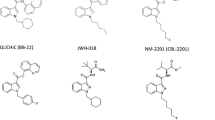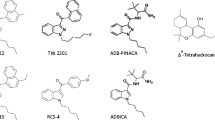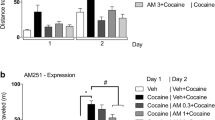Abstract
Rationale
A variety of behavioral procedures have been developed to assess cannabinoid activity in mice; however, the feasibility of establishing Δ9-THC as a discriminative stimulus in mice has not been documented.
Objective
One goal was to establish Δ9-THC as a discriminative stimulus in mice; after having done so, another goal was to examine the in vivo mechanism of action of Δ9-THC with other cannabinoids and noncannabinoids.
Materials and methods
C57BL/6J mice (n = 8) were trained to discriminate Δ9-THC (10 mg/kg i.p.) from vehicle while responding under a fixed ratio 30 schedule of food presentation.
Results
Mice satisfied the discrimination criteria in 18–98 (median = 67) sessions and the discriminative stimulus effects of Δ9-THC were dose-dependent (ED50 = 2.6 mg/kg). CP 55940 and WIN 55212-2 dose-dependently increased Δ9-THC-appropriate responding to 100% (ED50 = 0.032 and 0.45 mg/kg, respectively), whereas methanandamide and a variety of noncannabinoids (cocaine, ethanol, and ketamine) produced a maximum of 34% Δ9-THC-appropriate responding. The cannabinoid CB1 antagonist SR 141716A (rimonabant) surmountably antagonized the discriminative effects of Δ9-THC, CP 55940, and WIN 55212-2; methanandamide did not significantly modify the Δ9-THC discriminative stimulus.
Conclusions
The discriminative stimulus effects of Δ9-THC, CP 55940, and WIN 55212-2 are mediated by the same (i.e., CB1) receptors, whereas the effects of methanandamide or a metabolite of methanandamide are mediated at least in part by non-CB1 receptors. The discriminative stimulus effects of Δ9-THC in mice could be used to evaluate mechanisms of cannabinoid activity with approaches (e.g., inducible knockouts) currently unavailable in nonmurine species.



Similar content being viewed by others
References
Abadji V, Lin S, Taha G, Griffin G, Stevenson LA, Pertwee RG, Makriyannis A (1994) (R)-methanandamide: a chiral novel anandamide possessing higher potency and metabolic stability. J Med Chem 37:1889–1893
Balster RL, Prescott WR (1992) Δ9-tetrahydrocannabinol discrimination in rats as a model for cannabis intoxication. Neurosci Biobehav Rev 16:55–62
Baskfield CY, Martin BR, Wiley JL (2004) Differential effects of Δ9-tetrahydrocannabinol and methanandamide in CB1 knockout and wild-type mice. J Pharmacol Exp Ther 309:86–91
Bergman J, France CP, Holtzman SG, Katz JL, Koek W, Stephens DN (2000) Agonist efficacy, drug dependence, and medications development: preclinical evaluation of opioid, dopaminergic, and GABAA-ergic ligands. Psychopharmacology 153:67–84
Burkey RT, Nation JR (1997) (R)-methanandamide, but not anandamide, substitutes for Δ9-THC in a drug-discrimination procedure. Exp Clin Psychopharmacol 5:195–202
Chait LD, Evans SM, Grant KA, Kamien JB, Johanson CE, Schuster CR (1988) Discriminative stimulus and subjective effects of smoked marijuana in humans. Psychopharmacology 94:206–212
Childers SR (2006) Activation of G-proteins in brain by endogenous and exogenous cannabinoids. AAPS J 8:E112–E117
Compton DR, Gold LH, Ward SJ, Balster RL, Martin BR (1992) Aminoalkylindole analogs: cannabimimetic activity of a class of compounds structurally distinct from delta Δ9-tetrahydrocannabinol. J Pharmacol Exp Ther 263:1118–1126
De Vry J, Jentzsch KR, Kuhl E, Eckel G (2004) Behavioral effects of cannabinoids show differential sensitivity to cannabinoid receptor blockade and tolerance development. Behav Pharmacol 15:1–12
Deutsch DG, Chin SA (1993) Enzymatic synthesis and degradation of anandamide, a cannabinoid receptor agonist. Biochem Pharmacol 46:791–796
Fegley D, Gaetani S, Duranti A, Tontini A, Mor M, Tarzia G, Piomelli D (2005) Characterization of the fatty acid amide hydrolase inhibitor cyclohexyl carbamic acid 3′-carbamoyl-biphenyl-3-yl ester (URB597): effects on anandamide and oleoylethanolamide deactivation. J Pharmacol Exp Ther 313:352–358
Gold LH, Balster RL, Barrett RL, Britt DT, Martin BR (1992) A comparison of the discriminative stimulus properties of delta Δ9-tetrahydrocannabinol and CP 55,940 in rats and rhesus monkeys. J Pharmacol Exp Ther 262:479–486
Howlett AC, Barth F, Bonner TI, Cabral G, Casellas P, Devane WA, Felder CC, Herkenham M, Mackie K, Martin BR, Mechoulam R, Pertwee RG (2002) International Union of Pharmacology. XXVII. Classification of cannabinoid receptors. Pharmacol Rev 54:161–202
Järbe TU, Henriksson BG (1974) Discriminative response control produced with hashish, tetrahydrocannabinols (Δ8-THC and Δ9-THC), and other drugs. Psychopharmacologia 40:1–16
Järbe TU, Henriksson BG, Ohlin GC (1977) Δ9-THC as a discriminative cue in pigeons: effects of delta8-THC, CBD, and CBN. Arch Int Pharmacodyn Ther 228:68–72
Järbe TU, Lamb RJ, Makriyannis A, Lin S, Goutopoulos A (1998) Δ9-THC training dose as a determinant for (R)-methanandamide generalization in rats. Psychopharmacology 140:519–522
Järbe TU, Lamb RJ, Lin S, Makriyannis A (2001) (R)-methanandamide and Δ9-THC as discriminative stimuli in rats: tests with the cannabinoid antagonist SR-141716 and the endogenous ligand anandamide. Psychopharmacology 156:369–380
Järbe TU, Liu Q, Makriyannis A (2006) Antagonism of discriminative stimulus effects of delta(9)-THC and (R)-methanandamide in rats. Psychopharmacology 184:36–45
Kenakin T (1997) Pharmacologic analysis of drug-receptor interaction. Lippincott-Raven, Philadelphia, PA
Martin BR, Compton DR, Thomas BF, Prescott WR, Little PJ, Razdan RK, Johnson MR, Melvin LS, Mechoulam R, Ward SJ (1991) Behavioral, biochemical, and molecular modeling evaluations of cannabinoid analogs. Pharmacol Biochem Behav 40:471–478
McMahon LR (2006a) Characterization of cannabinoid agonists and apparent pA2 analysis of cannabinoid antagonists in rhesus monkeys discriminating Δ9-tetrahydrocannabinol. J Pharmacol Exp Ther 319:1211–1218
McMahon LR (2006b) Discriminative stimulus effects of the cannabinoid CB1 antagonist SR 141716A in rhesus monkeys pretreated with Δ9-tetrahydrocannabinol. Psychopharmacology 188:306–314
McMahon LR, Koek W (2007) Differences in the relative potency of SR 141716A and AM 251 as antagonists of various in vivo effects of cannabinoid agonists in C57BL/6J mice. Eur J Pharmacol, in press
Morozov A, Kellendonk C, Simpson E, Tronche F (2003) Using conditional mutagenesis to study the brain. Biol Psychiatry 54:1125–1133
National Research Council (2003) Guidelines for the care and use of mammals in neuroscience and behavioral research. National Academies Press, Washington, DC
Petitet F, Jeantaud B, Bertrand P, Imperato A (1999) Cannabinoid penetration into mouse brain as determined by ex vivo binding. Eur J Pharmacol 374:417–421
Ross RA, Gibson TM, Brockie HC, Leslie M, Pashmi G, Craib SJ, Di Marzo V, Pertwee RG (2001) Structure–activity relationship for the endogenous cannabinoid, anandamide, and certain of its analogues at vanilloid receptors in transfected cells and vas deferens. Br J Pharmacol 132:631–640
Shelton KL (2004) Substitution profiles of N-methyl-D-aspartate antagonists in ethanol-discriminating inbred mice. Alcohol 34:165–175
Solinas M, Tanda G, Justinova Z, Wertheim CE, Yasar S, Piomelli D, Vadivel SK, Makriyannis A, Goldberg SR (2007) The endogenous cannabinoid anandamide produces delta-9-tetrahydrocannabinol-like discriminative and neurochemical effects that are enhanced by inhibition of fatty acid amide hydrolase but not by inhibition of anandamide transport. J Pharmacol Exp Ther 321:370–380
Tallarida RJ (2000) Drug synergism and dose–effect data analysis. CRC, Boca Raton, FL
Wiley JL (1999) Cannabis: discrimination of “internal bliss”? Pharmacol Biochem Behav 64:257–260
Wiley JL, Martin BR (2003) Cannabinoid pharmacological properties common to other centrally acting drugs. Eur J Pharmacol 471:185–193
Wiley JL, Huffman JW, Balster RL, Martin BR (1995) Pharmacological specificity of the discriminative stimulus effects of Δ9-tetrahydrocannabinol in rhesus monkeys. Drug Alcohol Depend 40:81–86
Wiley JL, Golden KM, Ryan WJ, Balster RL, Razdan RK, Martin BR (1997) Evaluation of cannabimimetic discriminative stimulus effects of anandamide and methylated fluoroanandamide in rhesus monkeys. Pharmacol Biochem Behav 58:1139–1143
Wiley JL, Ryan WJ, Razdan RK, Martin BR (1998) Evaluation of cannabimimetic effects of structural analogs of anandamide in rats. Eur J Pharmacol 355:113–118
Acknowledgments
The authors thank G. Martinez for providing technical assistance.
Author information
Authors and Affiliations
Corresponding author
Additional information
Supported by U.S. Public Health Service Grants DA15468, DA19222, and AA012337.
Rights and permissions
About this article
Cite this article
McMahon, L.R., Ginsburg, B.C. & Lamb, R.J. Cannabinoid agonists differentially substitute for the discriminative stimulus effects of Δ9-tetrahydrocannabinol in C57BL/6J mice. Psychopharmacology 198, 487–495 (2008). https://doi.org/10.1007/s00213-007-0900-2
Received:
Accepted:
Published:
Issue Date:
DOI: https://doi.org/10.1007/s00213-007-0900-2




